July 21, 2012
Cause of by-election
Sitting Labor MP Bronwyn Pike resigned as Member for Melbourne on on 7 May. Read the profile for the seat of Melbourne at the 2010 state election.
Margin – ALP 5.8%
Incumbent MP
Bronwyn Pike, 1999-2012.
Geography
Inner Melbourne. The seat of Melbourne covers the Melbourne CBD and surrounding areas. It covers all parts of the City of Melbourne north of the Yarra River, as well as small parts of Moonee Valley and Yarra council areas. Melbourne covers the suburbs of Carlton, Carlton North, East Melbourne, Flemington, Kensington, Newmarket, North Melbourne, Parkville, West Melbourne and parts of Ascot Vale.
History
There was a district with the name “Melbourne” in the original Victorian Legislative Assembly at the 1856 election, before being abolished in 1859. It was recreated in 1889 as a single member district that has existed ever since. The seat has a long history of being held by the ALP, who have held it continously since 1908.
The recreated Melbourne district was won by Geoffrey Carter in 1889, and was won in 1900 by Labor candidate Edward Findley. Findley was expelled in 1901 for seditious libel after publishing an Irish article criticising the King in a radical union newspaper that he edited. He lost the following by-election, but went on to serve in the Senate from 1903 to 1917 and again from 1922 to 1928.
The 1901 by-election was won by Conservative candidate James Boyd, who supported conservative state governments, including serving as a minister from 1907 to 1908, when he stepped down. He was elected as a federal Liberal MP in 1913 and served until his defeat in 1919.
Melbourne was won by Labor candidate Alexander Rogers in 1908. He held the seat until 1924. He was succeeded by Thomas Hayes, who held the seat until 1955. That year, he left the ALP and joined the new ALP (Anti-Communist), the precursor to the Democratic Labor Party, but was defeated at the 1955 election.
The seat was then held by the ALP’s Arthur Clarey from 1955 until 1972. In 1972, Melbourne was won by the ALP’s Barry Jones. He held the seat until 1977, when he resigned to run for the federal electorate of Lalor, which he held until his retirement in 1998. He served as a minister in the Hawke government and went on to serve as National President of the ALP.
The seat was then filled by Keith Remington from 1977 to 1988, and Neil Cole from 1988 to 1999.
In 1999, Melbourne was won by Bronwyn Pike. She served as a minister for the entirety of the Bracks and Brumby governments. The seat of Melbourne was considered very safe in 1999, with Pike winning 63.8% of the two-party vote. In 2002, the Greens first stood in the seat, running Dr Richard di Natale, who polled 24% of the primary vote and reducing Pike’s margin to 1.9%, which remained almost exactly the same in 2006. Di Natale went on to stand for the Senate in 2007 and was elected to the Senate at the 2010 federal election.
The Greens had come close to winning in 2002 and 2006 on the back of preferences from the Liberal Party. In 2010 the Greens stood barrister and human rights advocate Brian Walters. At the 2010 federal election, the Liberal Party continued their track record of preferencing the Greens ahead of the Labor Party in Labor-Greens inner-city marginal seats in Sydney and Melbourne, which saw Adam Bandt elected as the Greens MP for the federal seat of Melbourne.
Bandt’s election, and the ensuing hung parliament which saw the Greens in the balance of power in the Senate and Bandt sharing the balance of power in the House of Representatives, triggered a backlash in the Liberal Party. In the Victorian state election three months later, the Liberal Party reversed their position on preferencing the Greens. In the inner-city Labor-Greens marginal seats of Melbourne, Richmond, Northcote and Brunswick, the Liberal Party preferenced the ALP ahead of the Greens.
In the seat of Melbourne, Pike suffered a swing of almost 9% on primary votes, with 4.5% going to the Greens and 5.9% going to the Liberal Party. This resulted in the ALP on 35.7%, the Greens on 31.9% and the Liberal Party on 28%. Despite the swing away from the ALP and towards the Greens and the Liberal Party, the Liberal preference decision helped Pike increase her two-party margin over the Greens from 1.9% to 5.8%.
Overall, the Liberal-National coalition won a narrow victory over the ALP, with 45 seats to the Coalition and 43 seats to Labor, with no seats going to independents or minor parties. Pike has followed the trend of other senior Labor MPs John Brumby and Rob Hulls in resigning from her seat, triggering a by-election.
Political situation
Melbourne has been held by the ALP continuously since 1955. The seat has been a very weak seat for the Liberal Party, with the Greens providing the main opposition to the ALP in this seat. At the 2002 and 2006 elections, it was the strongest seat for the Greens. In 2010, Brian Walters polled the highest primary vote in the state for the Greens, and it was the second-best seat for the Greens after preferences.
The 2010 results in Melbourne almost turned the seat into a three-cornered contest, with the third-placed candidate less than 8% behind the first-placed candidate on primary votes. This raised the prospect at the by-election of the Liberal Party coming in the top two. In such a progressive seat, this would almost certainly result in Greens preferences flowing to Labor or Labor preferences flowing to Greens. Such a scenario would effectively make Liberal preferences irrelevant, with the race being decided by which left-wing candidate comes in the top two. This scenario played out in Balmain at the New South Wales state election in 2011.
However it now appears that the Liberal Party will not stand. This will remove the question of which way the Liberals will preference, and turns the by-election into a head-to-head race between Labor and the Greens.
No Liberal candidate will mean that Liberal preferences will likely flow more strongly to the Greens than in 2010, although much less strongly than when the Greens received Liberal preferences in 2006. This probably will cut off 2-3% from the Labor margin of 55.8%. This margin will then be achievable for the Greens if they gain a modest swing. The ALP has performed much more strongly in Victoria following their defeat than in New South Wales or Queensland, and is only slightly behind in statewide polls. This suggests that the Labor vote will not collapse. However the Greens vote is strong in Melbourne and the work of federal member Adam Bandt in the electorate will likely be a boost to the Greens. All in all this seat could go either way.
Candidates
Andrew Crook at Crikey reports that Melbourne City councillor Jennifer Kanis is tipped as the likely successor to Bronwyn Pike as Labor candidate. Possible Greens candidates include former candidate Brian Walters, former councillor and Adam Bandt staffer Rose Iser and Melbourne City councillor Cathy Oke.
2010 result
| Candidate | Party | Votes | % | Swing |
| Bronwyn Pike | ALP | 13,116 | 35.67 | -8.89 |
| Brian Walters | GRN | 11,735 | 31.92 | +4.51 |
| Luke Martin | LIB | 10,281 | 27.96 | +5.88 |
| Rory Killen | SEXP | 1,061 | 2.89 | +2.89 |
| Peter Lazzari | IND | 231 | 0.63 | +0.63 |
| John Perkins | IND | 201 | 0.55 | +0.55 |
| Maxine Fensom | IND | 142 | 0.39 | +0.39 |
2010 two-candidate-preferred result
| Candidate | Party | Votes | % | Swing |
| Bronwyn Pike | ALP | 20,510 | 55.76 | +3.88 |
| Brian Walters | GRN | 16,273 | 44.24 | -3.88 |
Booth breakdown
Booths in Melbourne have been divided into four separate areas. Booths in East Melbourne and Carlton have been grouped as “East”. The three North Melbourne booths, along with Parkville and Hotham Hill, have been grouped as “North”. The three booths in the Melbourne CBD and Docklands have been grouped as “Central”, while Flemington, Kensington and Newmarked have been grouped as “North West”.
The Liberal Party topped the primary vote in Central. The Greens topped the poll in the East, while Labor topped the poll in the north and northwest. When you look at the second map, which shows which party topped the poll in each booth. The Liberal Party won the three booths at the southern end of the electorate. With the exception of one booth in Carlton, the remainder of the seat was split between Labor in the west and the Greens in the seat.
Also posted below are maps showing the Labor-Greens two-party vote, as well as the primary vote for the three main parties.
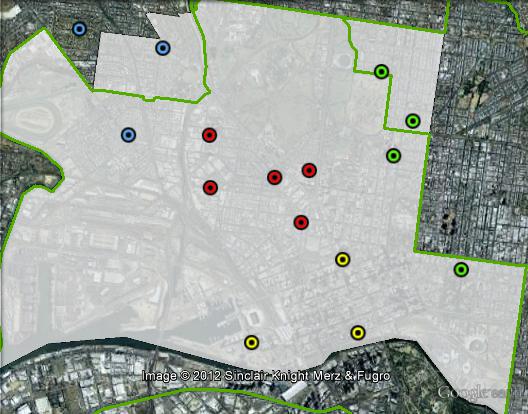
| Voter group | LIB % | GRN % | ALP % | ALP 2CP % | Total votes | % of votes |
| East | 28.23 | 32.38 | 32.14 | 54.70 | 7,476 | 20.32 |
| North | 23.96 | 32.22 | 35.74 | 56.84 | 6,061 | 16.48 |
| North West | 21.23 | 28.04 | 42.93 | 62.61 | 5,654 | 15.37 |
| Central | 34.13 | 29.02 | 27.20 | 55.72 | 3,182 | 8.65 |
| Other votes | 28.18 | 30.70 | 33.11 | 53.18 | 14,410 | 39.18 |
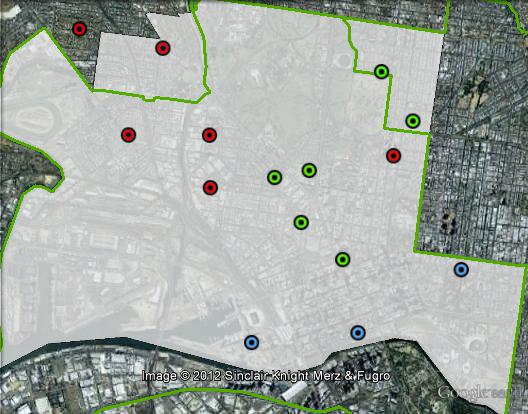
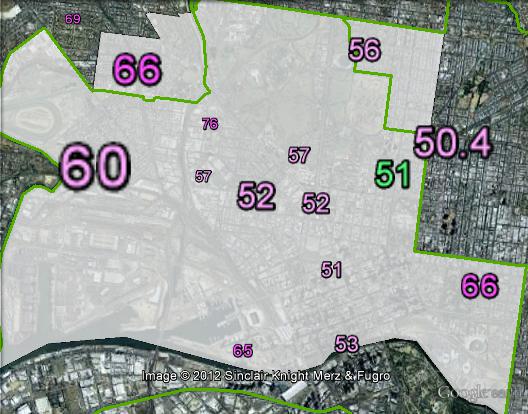
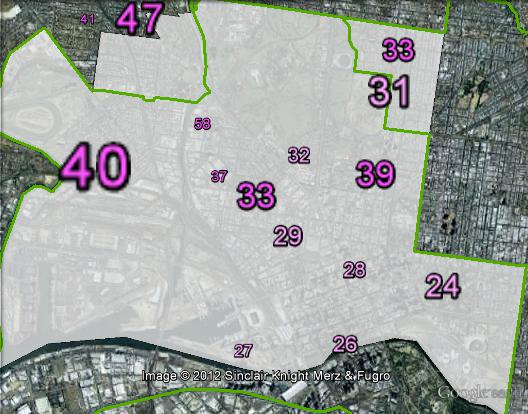
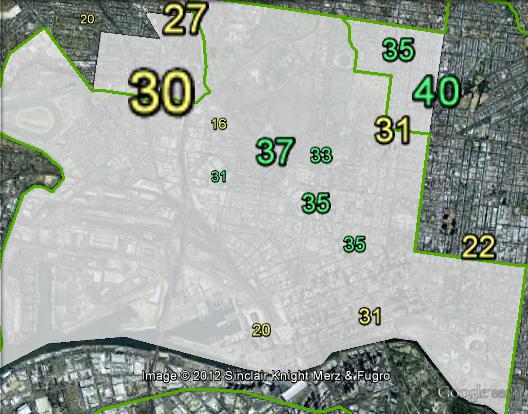
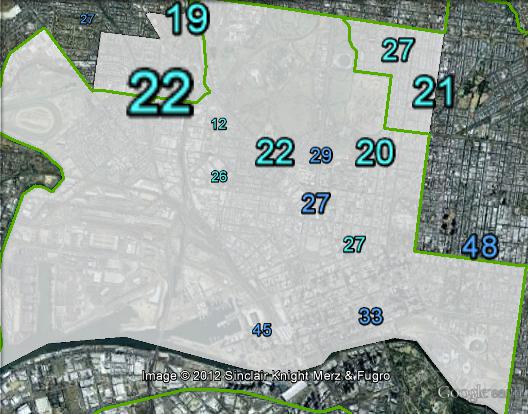


In the results section, you have 2007 where you mean 2010.
Cathy’s our candidate.
Labor’s strategy seems to be to ignore Greens and present b/e as opp to vote against Ted B & Libs.
Steven Mayne is running in the Melbourne by-election.
He is unlikely to do a preference deal with the ALP but is considering one with the Greens.
http://www.abc.net.au/news/2012-06-04/stephen-mayne-to-run-in-melbourne-by-election/4051592
This makes it harder for the ALP to win.
Offering a vote against Coalition is hardly a good way of attracting the Liberal voters on either primaries or preferences.
A vote for the ALP is a vote for the Roman Catholic Church and a vote for Julia Gillard’s anti same-sex marriage views! If you are a bigot and a homophobe,you are welcome to vote ALP!
Voting for a party candidate is to vote for a package of views and policies – it doesn’t mean you agree with them all – it’s an on balance issue. For example I would reckon there will probably be a proportion of people voting Green in Melbourne (perhaps 10%) who disagree with their policy on same sex marriage but reckon that on balance the Greens are the best option.
BEfore anyone thinks of voting for any party they should look at the party’s weebsite.
The Green’s websiote shows that theu can think of spending money like a drunken sailor. THeir is no thought of how are we goiung to pay for free tertiary education, upgraded public transport.
In the 1960’s an AUstralian Dentist DR Fred Schwartz wrote abook “YOU CAN TRUST A COMMUNIST: To be a COmmunist” It is just as true today that YOU CAN TRUST A GREEN : To be a GReen ” ie increase government interference in our lives spend OUR money on their pet projects, object to any one else’s morals but treat their own as sacrosant. Sarah Hanson Young’s recent attack on the ALP for lacking principles is an example of Green Arrogance. OF course we should put the Green’s last just as we put any other totalitarian party Com NAZI of White Supremacist last.
A party that spends money like a drunken sailor deserves to be treated like a drunken sailor. Like Winston CHurchill the Drunken Sailor will be sober in the morning but like Bessie Braddock the Greens will still be ugly in the morning.
Andrew Jackson
apjackson@hotkey.net.au
Poor Andrew! What a right-wing rant!
Went to the candidate forum – in order they were: a liberal guy who used to be on Melbourne council he’s a pharmacist who does community stuff and got it to be the council to introduce wheelie bins and separated waste (his sustainability creentials) andrattled thru some policies he put together, (which were not bad) Two best that caught my attention were a payroll levy to pay for TAFE and getting trams n trains to buy their electricty off solar power stations. He put up ideas and told us that he can get stuff done over the next two years with Ted Baillieu where the others cant. The Labor gal told us about her migrant parents, growing up, finding god (sorry I mean Labor) and that Labor has done good stuff. Finished by saying the only real choice was Ted Baillieu (I assume she meant the Liberal guy) or herself as they were the only ones who could form government. No substance to her speech tho. The Democrat guy got up and was the best speaker on the night he was good but had nothing to say really other than we all need to vote and follow the vibe of things. The socialist was a socialist and wanted the worlds workers to unite and is using the election as his democratic right to tell everyone what he thinks. Stephen Mayne spoke about being a serial campaigner who is in it for a lark – has no intention of winning and will give his preferences to the Greens because Julia hasnt introduced a $1 betting limit – wtf that has to do with things in this byelection I dont know. The radical guy was, well radical – he just wants to put a cat among the pigeons and give his preferences to the Greens. The mother earth guy got up and told us we have to go back to the stone age because we’re all living unsustainably. The Green told us she was a mother, footy follower, loved melbourne and that Adam Bandt had done a couple of things that noone in the audience could remember. She said she would be an indpendent – but I dont know how that works when she will be a Greens party candidate, lost me there. was still trying to work out what she meant when she finished speaking. Subtext was lots and lots of trams and trains, no tunnel and we all ride bicycles. The rest of the candidates were either too hard to hear or well, esoteric in their views on things. Nice touch was the secular guy siding with the christian chick but not on RI in schools. The Q&A was bit hokey. The liberal guy had the best questions and the audience got angsty when he wasnt allowed to answere the question on reunifying Carlton with Melbourne becuase it was one of his policies. End result Labor and Greens most of the questions from toady plants in the audience and looked the part but neither provided any substance. The Liberal guy, the Radical and Socilaist had content and something to say. The liberal guy asked the best question of the night to the Green – what would she do if Baillieu asks her to be Speaker?
its looks like that if the voters of the libs and sex party follow the HTV the greens will find it very hard to win. And why is ever one preferencing Berhan Ahmed?
Back in 1998, Queensland Labor voters defied their leaders’ appeals and preferenced One Nation. This allowed One Nation to win some of the 11 seats in the Queensland Parliament that it won. Voters there clearly didn’t share their leaders’ contempt for One Nation.
Now, Melbourne Liberal voters, denied by their disinterested leaders the chance to vote for one of their own, may well defy their leaders’ appeals and vote Green. This might knock Labor out of Melbourne. We’ll see if voters here share their leaders’ contempt for the Greens.
If it happens, there’ll be a message for all political leaders and their media cheer squads, left and right alike: we vote as we see fit, and if you don’t like it, you know where to go.
I find it difficult in the current environment that former liberal voters would place their vote with the greens. One would assume that traditional liberal voters will most likely go to conservative minors such as DLP and FF (and maybe even some ALP disenchanted voters) and the newly formed Australian Christians, I cant see them placing their votes with the greens, the Democrats or the ultimate cop out the Sex Party. There is no doubt that the informal vote will be high but I don’t think that or the large proportion of minors preferencing the greens will be enough to upset the ALP. I therefore predict that Melbourne will remain in the ALP stable and that the green influence on politics will continue to diminish.
Toby, stating exactly why the Green influence on politics will “continue to diminish” requires some argument not an assertion. Some political analysis rather than a statement of political preference would be a helpful contribution to the debate.
Has it diminished yet? In what ways? Are you referring to voting, electoral representation or what?
Don’t feed the DLP trolls, folks.
Doug. I thought that statement was obvious. One only has to look at the Niedre By-election which saw a drop in the Greens vote even though there was no Liberal/National endorsed candidate.
In Queensland we saw a total collapse of the ALP yet the Greens were not able to capitalize on that and even lost grounds in seats they looked a chance to win.
This is the Greens best chance of a lower house seat anywhere in Australia and in recent history and will give a clear indication of whether their party is now on the decline.
If they start to lose their support in Melbourne then its only 12 months before they commence their rapid decline. I agree with Ben though about the rise of the conservative minors in Queensland and elsewhere as members move between the parties and form alliances. The rise of the KAP in Queensland scared many a DLP supporter but has also given new interest in the DLP up here. The Aust christians polled well in Niedre where previously Liberal Voters may have gone to the greens in protest they certainly dont seem to be doing so now. I dont think anyone can underestimate the result for the greens in this one.
Why do you think the ALP is tryiing to distance itself ?